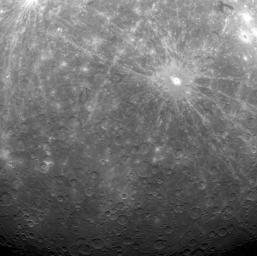
|
Equator to Pole (almost)
- Click the image above for a larger view
- Full-Res JPEG (1024 x 1020) (139.9 kB)
- Full-Res TIFF (1024 x 1020) (1.0 MB)
Caption:
The upper right corner of this image lies at 1° N, just above Mercury's equator, whereas the lower center-left portion is at about 83° S, just 7° from Mercury's south pole. Unusual impact craters Berkel and Derain are seen in the upper right, and the extensive bright ejecta and rays of Debussy dominate much of the middle of the view. The image is not map projected but has north approximately toward the top.
Date acquired:
March 31, 2011
Image Mission Elapsed Time (MET):
210054466
Image ID:
73261
Instrument:
Wide Angle Camera (WAC) of the Mercury Dual Imaging System (MDIS)
WAC filter:
7 (748 nanometers)
Center Latitude:
-48.7°
Center Longitude:
2.1° E
Resolution:
2553 meters/pixel
Scale:
The scene is approximately 2800 kilometers (1750 miles) across
Background Info:
On March 17, 2011 (March 18, 2011, UTC), MESSENGER became the first spacecraft ever to orbit the planet Mercury . The mission is currently in its commissioning phase, during which spacecraft and instrument performance are verified through a series of specially designed checkout activities. In the course of the one-year primary mission, the spacecraft's seven scientific instruments and radio science investigation will unravel the history and evolution of the Solar System's innermost planet. Visit the Why Mercury? section of this website to learn more about the science questions that the MESSENGER mission has set out to answer.
These images are from MESSENGER, a NASA Discovery mission to conduct the first orbital study of the innermost planet, Mercury. For information regarding the use of images, see the MESSENGER image use policy .
Cataloging Keywords:
| Name | Value | Additional Values |
|---|---|---|
| Target | Mercury | |
| System | ||
| Target Type | Planet | |
| Mission | MESSENGER | |
| Instrument Host | MESSENGER | |
| Host Type | Orbiter | |
| Instrument | Mercury Dual Imaging System (MDIS) | |
| Detector | Wide Angle Camera (WAC) | |
| Extra Keywords | Crater, Grayscale, Impact, Map, Radio | |
| Acquisition Date | ||
| Release Date | 2011-04-05 | |
| Date in Caption | 2011-03-31 | |
| Image Credit | NASA/Johns Hopkins University Applied Physics Laboratory/Carnegie Institution of Washington | |
| Source | photojournal.jpl.nasa.gov/catalog/PIA14211 | |
| Identifier | PIA14211 | |
